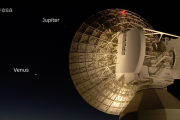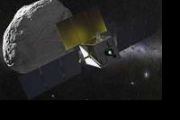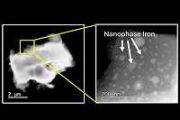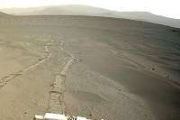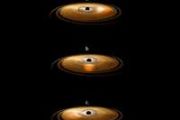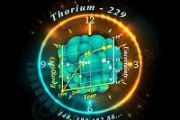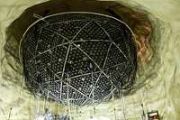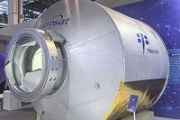
Copernical Team
China eyes Neptune for groundbreaking ice giant mission
 China is preparing to push deeper into the solar system with an ambitious new phase in its deep space exploration program, including a Mars sample-return mission and a journey to Jupiter. Now, Chinese scientists are setting their sights even farther-toward the ice giants Uranus and Neptune.
These remote, largely unexplored planets contain clues to the solar system's origins, according to Y
China is preparing to push deeper into the solar system with an ambitious new phase in its deep space exploration program, including a Mars sample-return mission and a journey to Jupiter. Now, Chinese scientists are setting their sights even farther-toward the ice giants Uranus and Neptune.
These remote, largely unexplored planets contain clues to the solar system's origins, according to Y Moon erosion by solar wind far less than expected finds lunar rock study
 The Moon's fragile exosphere, a sparse envelope of gas surrounding the lunar body, is mainly generated by interactions between the Moon's surface and external forces. Until now, scientists believed the solar wind played a major role in this process. But new research led by Vienna University of Technology (TU Wien) challenges that assumption.
Using original lunar rock from NASA's Apollo 16
The Moon's fragile exosphere, a sparse envelope of gas surrounding the lunar body, is mainly generated by interactions between the Moon's surface and external forces. Until now, scientists believed the solar wind played a major role in this process. But new research led by Vienna University of Technology (TU Wien) challenges that assumption.
Using original lunar rock from NASA's Apollo 16 Sidus Space debuts LunarLizzie 800kg lunar platform built for real time AI terrain intelligence
 Sidus Space has introduced LunarLizzie, its most advanced 800kg-class spacecraft engineered specifically for lunar and cislunar missions. Equipped with onboard AI, LiDAR, and hyperspectral imaging, the platform aims to deliver near real-time intelligence on lunar terrain and environmental conditions without ground-based dependency.
Designed for both government and commercial missions, Luna
Sidus Space has introduced LunarLizzie, its most advanced 800kg-class spacecraft engineered specifically for lunar and cislunar missions. Equipped with onboard AI, LiDAR, and hyperspectral imaging, the platform aims to deliver near real-time intelligence on lunar terrain and environmental conditions without ground-based dependency.
Designed for both government and commercial missions, Luna China Focus: Chinese scientist details first planned Mars sample-return mission Tianwen 3
 China's first Mars sample-return mission, Tianwen 3, is scheduled for launch around 2028, with the goal of returning no less than 500 grams of Martian samples to Earth by around 2031, according to the mission's chief scientist.
Hou Zengqian, an academician of the Chinese Academy of Sciences and chief scientist of the Tianwen 3 mission, together with his collaborators, recently published an
China's first Mars sample-return mission, Tianwen 3, is scheduled for launch around 2028, with the goal of returning no less than 500 grams of Martian samples to Earth by around 2031, according to the mission's chief scientist.
Hou Zengqian, an academician of the Chinese Academy of Sciences and chief scientist of the Tianwen 3 mission, together with his collaborators, recently published an Lunar habitat module project advances under Thales Alenia Space and ASI agreement
 Thales Alenia Space has signed a contract with the Italian Space Agency (ASI) to carry out the preliminary design and technology development for the Multi-Purpose Habitation (MPH) module, set to become the first human habitat on the Moon's surface. The MPH module is scheduled for launch in 2033 from NASA's Kennedy Space Center under the Artemis Accords between NASA and ASI.
As part of the
Thales Alenia Space has signed a contract with the Italian Space Agency (ASI) to carry out the preliminary design and technology development for the Multi-Purpose Habitation (MPH) module, set to become the first human habitat on the Moon's surface. The MPH module is scheduled for launch in 2033 from NASA's Kennedy Space Center under the Artemis Accords between NASA and ASI.
As part of the Skyfall Mars helicopter fleet to scout future astronaut landing sites
 Skyfall, a forward-looking Mars helicopter concept developed by AeroVironment (AV) in collaboration with NASA's Jet Propulsion Laboratory (JPL), aims to support future human exploration of the Red Planet by 2028. The system features a fleet of six autonomous scout helicopters designed to explore potential astronaut landing zones.
Each rotorcraft would operate independently, capturing high-
Skyfall, a forward-looking Mars helicopter concept developed by AeroVironment (AV) in collaboration with NASA's Jet Propulsion Laboratory (JPL), aims to support future human exploration of the Red Planet by 2028. The system features a fleet of six autonomous scout helicopters designed to explore potential astronaut landing zones.
Each rotorcraft would operate independently, capturing high- Curiosity Rovers Boxwork Campaign Reaches New Heights on Mount Sharp
 Curiosity has made significant progress in its ongoing exploration of the intricate boxwork terrain along the slopes of Mount Sharp. The past several sols have brought the rover from the base of a steep ridge to a resting point within a nearby hollow, offering increasingly detailed views of these unique Martian formations. This marks a new phase in Curiosity's campaign to analyze the composition
Curiosity has made significant progress in its ongoing exploration of the intricate boxwork terrain along the slopes of Mount Sharp. The past several sols have brought the rover from the base of a steep ridge to a resting point within a nearby hollow, offering increasingly detailed views of these unique Martian formations. This marks a new phase in Curiosity's campaign to analyze the composition Mars glaciers are purer and more uniform than previously thought
 On the slopes of Martian mountains and craters clings what appears to be flowing honey, coated in dust and frozen in time. In reality, these features are incredibly slow-moving glaciers, and their contents were once thought to be mostly rock enveloped in some ice.
Work over the last 20 years has demonstrated that at least some of these glaciers are mostly pure ice with only a thin cover of
On the slopes of Martian mountains and craters clings what appears to be flowing honey, coated in dust and frozen in time. In reality, these features are incredibly slow-moving glaciers, and their contents were once thought to be mostly rock enveloped in some ice.
Work over the last 20 years has demonstrated that at least some of these glaciers are mostly pure ice with only a thin cover of NASA says it will lose about 20 percent of its workforce
This request seems a bit unusual, so we need to confirm that you're human. Please press and hold the button until it turns completely green. Thank you for your cooperation!
Press and hold the button
If you believe this is an error, please contact our support team.
185.132.36.159 : 2fec995a-d4e5-478a-8158-b3a91699
European Vega C rocket ferries satellites into orbit
This request seems a bit unusual, so we need to confirm that you're human. Please press and hold the button until it turns completely green. Thank you for your cooperation!
Press and hold the button
If you believe this is an error, please contact our support team.
185.132.36.159 : 5add38ef-574e-4fd2-95f8-096587b4












